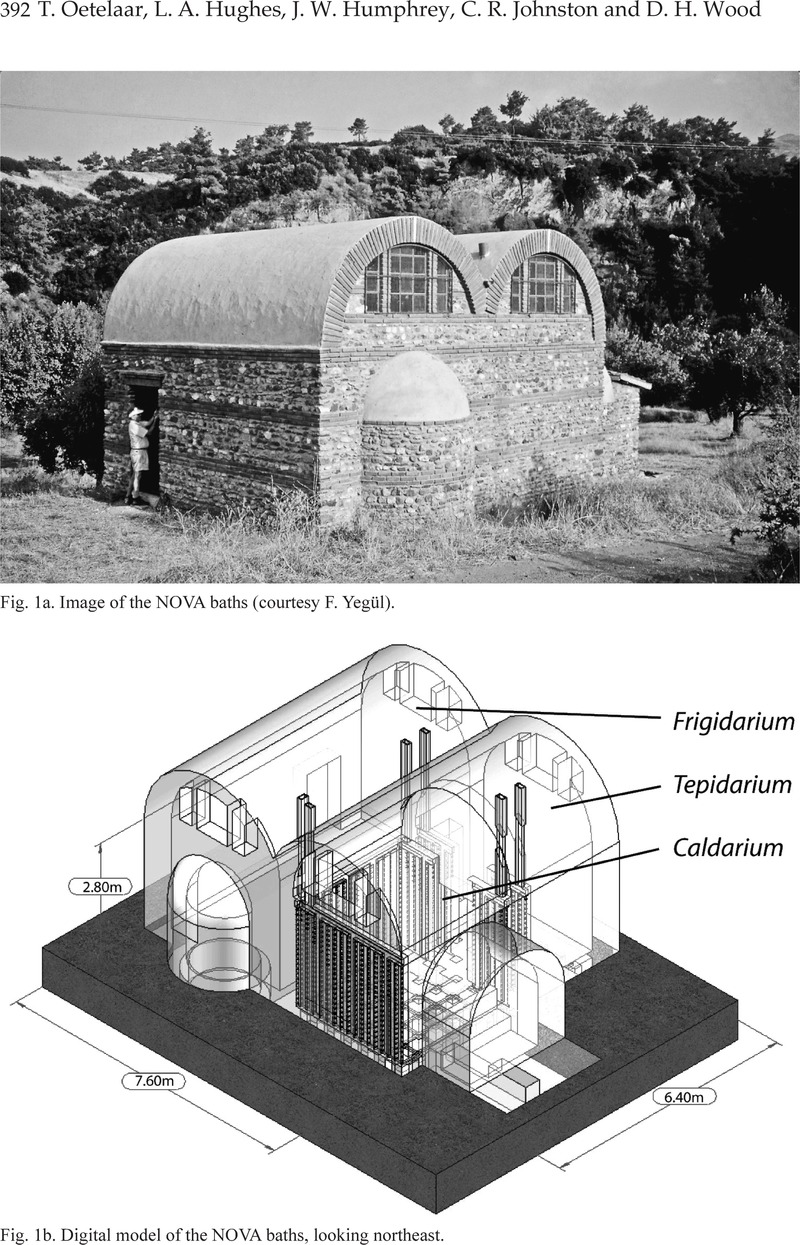Article contents
A computational investigation of the thermal environment of the caldarium in a replica Roman bath
Published online by Cambridge University Press: 27 November 2014
Abstract

- Type
- Archaeological Notes
- Information
- Copyright
- Copyright © Journal of Roman Archaeology L.L.C. 2014
References
1 Yegül, F. K. and Couch, T., “Building a Roman bath for the cameras,” JRA 16 (2003) 153–77Google Scholar.
2 For previous studies on the thermal environment and hypocaust, see Kretzschmer, F., “Hypocausten,” SaalJb 12 (1953) 7–41 Google Scholar; Thatcher, E., “The open rooms of the Terme del Foro at Ostia,” MAAR 24 (1956) 167–264 Google Scholar; Rook, T., “The development and operation of Roman hypocausted baths,” JArchSci 5 (1978) 269–82Google Scholar; Jorio, A., “Sistema di riscaldamento nelle antiche terme pompeiane,” BullCom 86 (1978–1979) 167–89Google Scholar; Hüser, H., “Wärmetechnische Messungen an einer Hypokaustenheizung in der Saalburg,” SaalJb 36 (1979) 12–30 Google Scholar; Baatz, D., “Heizversuch an einer Rekonstruierten Kanalheizung,” SaalJb 36 (1979) 31–44 Google Scholar; Ring, J. W., “Windows, baths, and solar energy in the Roman empire,” AJA 100 (1996) 717–24CrossRefGoogle Scholar; Basaran, T. and Ilken, Z., “Thermal analysis of the heating system of the small bath in ancient Phaselis,” Energy and Buildings 27 (1998) 1–11 CrossRefGoogle Scholar; T. Basaran, A. Erek, G. Uluans and A. Ersoy, “Energy analysis of the Roman bath in Metropolis” (paper delivered at 2nd Int. Exergy, Energy and Environment Symposium, Kos, July 2005); and T. Basaran, “The heating system of the Roman baths,” ASHRAE [American Society of Heating, Refrigerating and Air Conditioning Engineers] Transactions 113 (2007) 199–205 Google Scholar.
3 Yegül, F. K., Baths and bathing in classical antiquity (Cambridge 1995) 356–89Google Scholar; id., Bathing in the Roman world (Cambridge 2010) 80-90.
4 For a description of the basics of CFD for engineers, see Chung, T. J., Computational Fluid Dynamics (Cambridge 2010) 80–90 CrossRefGoogle Scholar; Lomax, H., Pulliam, T. and Zingg, D., Fundamentals of Computational Fluid Dynamics (Berlin 2004)Google Scholar; Anderson, J., Computational Fluid Dynamics (New York 1995) 356–89Google Scholar.
5 Oetelaar, T., Johnston, C. R., Wood, D. H., Hughes, L. A. and Humphrey, J. W., “A computational investigation of a room heated by subcutaneous convection — a case study of a replica Roman bath,” Energy and Buildings, 63 (2013) 59–66 CrossRefGoogle Scholar, lays out the engineering details of the model.
6 Turbulence is a measure of the randomness in fluid flow. It is most recognizable as eddies or white water in a stream. In CFD there are many different ways of calculating turbulence but, because randomness is virtually impossible to compute, the main methodologies can only approximate the turbulence phenomena. Thus the choice of turbulence model can influence the results dramatically.
7 For derivation of this value, see Oetelaar, T. and Johnston, C. R., “Determination of the Convective Heat Transfer Coefficient of hot air rising through terracotta flues,” Trans. Canadian Soc. Mechanical Engineering 36 (2012) 413–27CrossRefGoogle Scholar.
8 Linde, N. (writer) and Linde, N. (director), Barnes, M. (producer), Secrets of lost empires: Roman Bath (February 22, 2000) (NOVA, PBS, Boston, MA)Google Scholar.
9 It is a widely-used custom for Turkish hamams (the descendants of Roman baths) to have similar doors made of cloth or leather; some even have counter-weights to close them after the patron has passed through.
10 While there is no direct literary or archaeological evidence in Roman baths for the presence of cloth doors, Yëgül (in the NOVA program; see n.9) hypothesized the presence of a cloth door in the NOVA baths.
- 2
- Cited by


